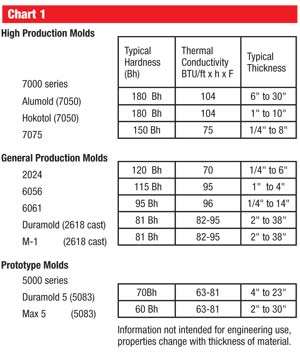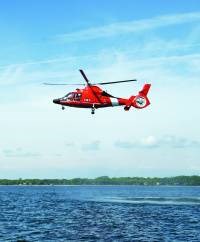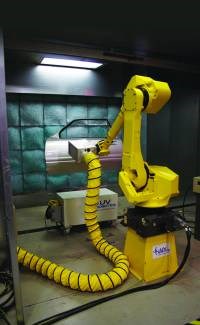Flying High
UV-curable powders set to make inroads in military, aerospace applications
#military #aerospace
Members of the United States military depend on the effectiveness and reliability of the various weapon systems they use every day. These systems must function as intended in extremes of temperature and humidity, corrosive atmospheres, blowing dust and sand, and exposure to ultraviolet (UV) radiation as well as possible chemical, biological and radiological agents.
Practically all weapon systems have some form of protective coating on them. For the most part, these coatings protect metal surfaces such as steel, aluminum, magnesium and titanium. Newer and more modern systems are now using composite materials in greater amounts than ever before. Specialty coatings can provide other special benefits like low infrared or radar signature and chemical and biological resistance, to name just a few.
Featured Content
Of the various parameters that coatings on military equipment must meet, the single most important is corrosion resistance. Studies by the U.S. Department of Defense indicate that, in 2005, the cost of corrosion alone exceeded $20 billion dollars. Temperature-sensitive metal substrates such as tempered aluminum, magnesium alloys and steels are used in the manufacture and sustainment of weapon systems and ground support equipment. To protect these corrosion-sensitive materials, DoD continues to utilize coatings containing hexavalent chromium and various solvents that are considered both Volatile Organic Compounds (VOCs) and Hazardous Air Pollutants (HAPs). Efforts to reduce or eliminate use of hazardous materials and volatile compounds are funded through DoD programs like the Environmental Security Technology Certification Program (ESTCP) and the Strategic Environmental Research and Development Program (SERDP).
Powder coatings offer one possible way to eliminate hazardous materials and solvents. Developed in the 1960s as an alternative to wet-applied coatings, powder materials contain no solvents and thus emit no toxic or hazardous gases when applied or cured.
Early powder coatings were based on epoxy-type materials and required temperatures in the range of 400°F and up to cure properly. More modern powder materials can cure at energy-saving temperatures as low as 250°F and containing corrosion inhibitor packages. Nevertheless, even low-temperature curable powder coatings require use of an oven to cure. Early powder materials coatings were excellent barrier coatings; however, if corrosion resistance was a consideration, the powder had to be applied over a corrosion-resistant primer.
Another issue with some early powder formulations was the limitations associated with electrostatic gun capabilities. Early designs had difficulties in overcoming what is known as the Faraday cage effect, where charged powder particles repel one another in tight corners, resulting in very thin films or no coverage in these locations.
Advances in powder formulation have made powder materials a serious competitor to traditional wet coatings. New gun designs have practically overcome the Faraday cage effect, and newer powder formulations now make it possible to apply thin films (<1 mil). Powder materials now come in virtually any color and any finish. Powders have been formulated to cure at temperatures 250°F and below. With the addition of corrosion inhibitor packages specifically designed for powders, powder finishes can now be applied as a single coat, with excellent ASTM B 117 salt-spray results.
A promising new cure technology for powder coating is ultraviolet-curable powder coatings (UVCPC). The use of UVCPCs allows coating of unlimited aircraft part sizes using UV lamp sources instead of conventional ovens. Use of robots to carry the lamps opens up new possible applications for powder materials on military weapon systems of all types and sizes.
Replacing Liquids
With modern, lower-temperature curing and UV-curable powder formulations and improvements in electrostatic gun technology, the potential advantages of using powder coatings in a military environment are great. Being dry powders, coating materials require no VOCs as thinners or for cleaning of guns and hardware. The lack of solvent also means that ventilation requirements are lower, resulting in energy savings over conventional sprayed coatings. Powders contain no chromium, so they do not contribute to HAPs.
Because the components of powder coatings are non-hazardous, hazardous wastes and their associated costs are eliminated. And, the ability to apply a single coat means considerable improvements in overall processing time. Cure times for powders are measured in minutes, not days, and results in rapid turnaround for time-critical military components.
One very big advantage of powder coatings is the ability to have transfer efficiencies as high as 98% through use of reclaim. This compares with a very optimistic estimate of 60% for wet coatings.
Components that have been sprayed with UV-curable powder are cured by illumination with IR and UV lamps, which melt the powder and cause it to flow and wet the substrate surface. Temperatures of 175–240°F are sufficient for melting and flow, and the underlying substrate will not see these same temperatures—only the powder and the surface of the substrate are heated.
Curing takes place when the still-hot melted powder is subjected to a UV source. This triggers a photopolymerization reaction, which generates a crosslinked resin matrix. The entire process takes minutes, with the actual curing phase (UV light exposure) being measured in seconds.
Because aerospace and marine coatings are pigmented, careful selection of UV lamps and the correct mix of photoinitiators are critical to obtaining adequate through-cure of the coating. Although many colors are possible with UV-curable powders, the predominant military colors are shades of gray, different shades of white, and to a lesser extent, reds and greens. Gray and white are challenges, because the titanium dioxide white pigment absorbs much of the UV bandwidth, and black pigments added to create grays absorb all light.
UVCPCs offer multiple advantages over both liquid coatings and conventionally cured powders. They eliminate the need for a curing oven, allowing large, bulky components or systems that could not otherwise fit in an oven to be powder coated and cured. Another advantage is that thermal exposure to the component is greatly reduced—it no longer gets heat-soaked by the oven. UV-curable powder is faster to apply and cure than wet spray-applied coatings because it is applied as a single coat. A reduced energy signature is yet another advantage, because curing energy is focused to a specific part only as long as it’s needed. And finally, UVCPCs, like all other powder coatings, can take advantage of reclaim and have transfer efficiencies greater than 90%.
Robotic Curing
In the past 20 years, UV curing has evolved from use on predominantly flat, two-dimensional applications such as tiles, panels and so on to complex, three-dimensional shapes such as automotive wheels and body panels. Because UV curing requires ultraviolet light to reach every square inch of a complex shape to get proper cure, curing something like a car body or a custom wheel can be a daunting challenge. Early attempts to accomplish this task saw the creation of light tunnels containing large numbers of fixed UV lamps.
Using a large light tunnel has a significant number of drawbacks. Every time a part changes, lights in the tunnel have to be repositioned. Because there are many lights, energy requirements start to come close or exceed the cost of operating a curing oven. And the many lights require significant quantities of spare lamps.
These challenges are even more pronounced in a military depot environment. Unlike an automotive finishing line, which may send the same car body through over and over, day in and day out, a military depot may work on wheels and other components of varying size.
Use of a robot for curing provides a number of significant advantages. Instead of many lights, a robot can carry a single lamp to all surfaces of the object to be cured. Robots can be programmed to bring the light source extremely close to the subject area, increasing the radiant energy and speeding the curing process. By eliminating the many lights, robotics greatly reduce the cost in terms of power and spare bulbs. And, because parts to be coated are mapped initially and these “maps” are stored in the computer, robots can be reconfigured in seconds to handle a variety of component types and sizes. Most importantly, a robot being used to do UV curing is well suited to cure large and complex parts. For example, multiple robots in a gantry robotic system could be used to apply and cure a UV coating on entire aircraft, or even ships.
Technology Demonstration
In light of advances in both robotics and UV curing, the Department of Defense, through its Environmental Security Technology Certification Program (ESTCP), has funded an effort to demonstrate a UV-curable powder coating system coupled with a robotic curing system.
The objectives of ESTCP Project WP-0801 are, first, to demonstrate a VOC-free, HAP-free, UV-curable powder coating on DoD hardware; and second, demonstrate that this UV-curable powder can be robotically cured. The marriage of robotics and UV-curable powder coatings offers a non-hazardous and cost-effective alternative to existing painting procedures. In this project, we mounted both the IR heating source used for initial powder melting as well as the UV light source onto an industrial robot.
Although robots are used extensively in both OEM and depot environments, UV-curable coatings, powder or wet, are not. For a UV-curable powder to be applicable in an aerospace environment, it must first demonstrate that it can perform as well as any wet-applied military specification coating. Powder has an additional challenge because the intent is to use it as a single coat; it must have the corrosion resistance and durability of both the primer and topcoat it replaces. Applicable specifications for the project are MIL-PRF-23377 (primer performance) and MIL-PRF-85285 (topcoat performance). Additionally, a powder coating needs to be formulated for high-gloss, semi-gloss, and flat finishes.
To demonstrate the suitability of a UV cure powder coating in a military environment, this project will coat a number of operational components and put them into regular use for up to 18 months. To date, the components that will be demonstrated in the field with UVCPC includes U.S. Navy P-3 aircraft radomes, wheels and landing gear; Air Force KC-135 tanker refueling booms; main landing gear doors of a Coast Guard HC-130 aircraft; and an aircraft ground support tug from the Coast Guard. To demonstrate the ability to coat and cure large and bulky items, the project also intends to powder coat and robotically cure the exterior of an HH-65 helicopter and wing flap from a KC-135 aircraft.
Project researchers are currently evaluating two powders from different vendors. For this effort, a gloss white and semi-gloss gray will be used. Both powders will undergo very strict validation testing to ensure they meet MIL specification requirements.
Powders will be applied using a standard commercially available corona powder spray gun and cured using the robotic curing system. The project is also continuing to evaluate some emerging technologies related to alternative UV light sources as well as application methods.
Work on the project is already under way and is scheduled for completion over the next two years. A Joint Test Protocol was submitted in September. The curing robot has been acquired and integration is underway. Component identification is completed, and UV source evaluations are ongoing. Validation testing should be starting in December 2008, a draft Demonstration Plan is due for submission by June 2009 and field service/demonstration is slated to begin in March 2010. A draft Joint Test Report is due in September 2010, with the final report due in March 2012.
RELATED CONTENT
-
Andrews Powder Coating Earns Space Flight Qualification
The first-tier aerospace powder coating supplier recently had its MIL-SPEC powder coatings qualified for coating power supplies for a classified military satellite program.
-
Finishing High Reliability, Function Critical Parts
From safety critical automotive and aerospace components to lifesaving medical micro-components and implantable devices, Indiana-based Electro-Spec finishes applications that require zero failure rates.
-
Back in Black: Birchwood Casey's black oxide
Black anodize finishes have long been favored for their thick, hard coating properties. It is also these very same characteristics that often make the anodizing unusable for many military and aerospace applications.





















